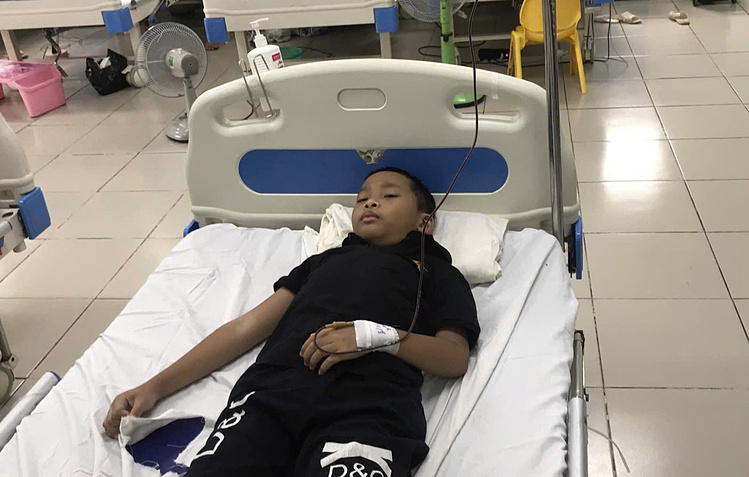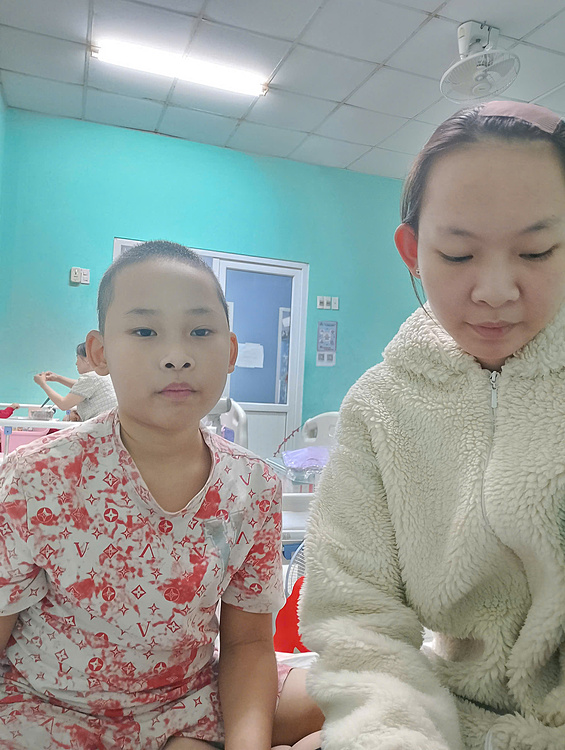On 23/6, Bao dozed on a small bed. Beside him was his mother, Cai Thi Van, 41, her eyes dark with fatigue from many sleepless nights, her body thin after nearly 10 years of caring for her sick son. After the bone marrow transplant in February, Bao was discharged but remains weak, with low immunity. He still can't return to school and requires frequent check-ups and close monitoring.
"For the past 10 years, my son has lived thanks to the blood of others. I'm incredibly grateful to the doctors for giving him a chance at life, a future no longer dependent on the hospital," she said.
 |
Bao receiving treatment at the hospital. Photo: Family provided |
Bao grew up in a modest family. His father, Nguyen Chanh Hung, 57, is a painter earning 5 million VND per month, while Van is a homemaker. Despite this, Bao has always been a good student. At the age of two, during a check-up for a toothache and pale skin, doctors at Hue Central Hospital diagnosed him with thalassemia. This inherited blood disorder causes anemia and requires regular blood transfusions and iron chelation therapy.
"When the doctor told me, I was stunned. I couldn't believe my little boy would have to rely on other people's blood for the rest of his life," Van recalled.
Once or twice a month, the family took Bao to the hospital for 4-hour blood transfusions, whenever he felt ill, tired, or jaundiced. While health insurance covered the transfusions, the medication costs were substantial. The family spent an average of 8-10 million VND monthly, totaling over a billion VND in almost 10 years. Given their difficult financial situation, Van had to borrow money from various sources.
As the money dwindled, Van often ate uncooked instant noodles to save money, praying that Bao wouldn't experience shock or complications during transfusions. "Let me bear the pain, not my son," she confided.
When Bao was younger, Hung often missed work to care for him. As he grew older, Bao would ask his mother, "Why do I have to go to the hospital for blood? Will I still need transfusions when I grow up?" His innocent questions broke Van's heart, but she patiently explained, "Your body is different from other children's, so you need transfusions." Gradually, he accepted it. With his arms covered in bruises from IV insertions, he became braver, less afraid, and always eager to study. From grades 1 to 4, he was an excellent student. By grade 5, his health declined, forcing him to miss school for treatment.
 |
The patient had to go to the hospital for monthly blood transfusions, which were costly and tiring. Photo: Family provided |
Doctors advised that a bone marrow transplant was the only cure, otherwise, his life would be tied to the hospital. Long-term transfusions and iron chelation therapy carried the risk of iron overload, leading to heart failure and cirrhosis. However, a bone marrow transplant cost around 500 million VND, and the isolation room fees weren't covered by insurance.
During those seemingly endless days in the hospital, Bao received financial support from the Mat Troi Hy Vong program (Hope Fund - VnExpress) for the transplant. Tests revealed his 18-year-old sister, Nguyen Thi Bao Ngoc, was a match. Ngoc's stem cells were harvested and transplanted to Bao.
During the 7-hour transplant, Van was sleepless with worry. Afterward, Bao suffered from drug and blood shock but was successfully resuscitated. He experienced hair loss and excessive body hair growth as side effects, leaving him sad and frightened. Van reassured him, "It's because of the medicine. Your hair will grow back," and he tried to stay positive.
By the end of April, Bao's health stabilized, and he was discharged, bringing immense joy to the family. Doctors advised weekly check-ups for 6 months to a year to confirm his recovery.
 |
Bao and his sister at the hospital. Photo: Family provided |
Thalassemia places a heavy burden on families. The average treatment cost from birth to age 30 is about 3 billion VND. In Vietnam, over 12 million people are estimated to carry the thalassemia gene. Many are unaware because they show no symptoms or only mild anemia. Annually, over 2,000 billion VND and 500,000 units of safe blood are needed for treatment.
Because thalassemia is hereditary, family members should be screened. Two carriers should avoid marriage, or undergo prenatal diagnosis if they do marry. If two carriers have children, 50% will be carriers, 25% will have severe thalassemia requiring lifelong transfusions, and only 25% will be healthy.
Thalassemia is a societal issue, impacting the economy and future generations. Prevention through screening and genetic testing before marriage and pregnancy is the most effective control measure. Carriers should seek medical advice and monitoring.
"For almost 10 years, we lived in daily fear. Now, for the first time, I dare to believe in a future. I'm grateful that my son has a chance to live like other children," Van said.
Aiming to inspire hope in children with cancer, the Hope Fund collaborates with Ong Mat Troi program on the Mat Troi Hy Vong project. Every contribution brings a ray of hope to the nation's future.
Readers can contribute to the program here:
Program Name: Ten cua ban - Mat Troi Hy Vong
Program ID: 195961
Thuy Quynh












